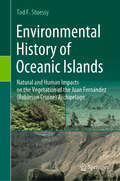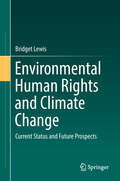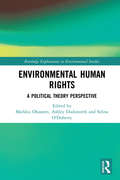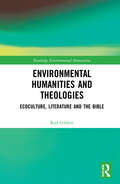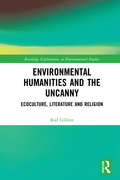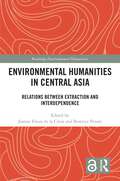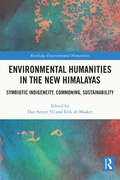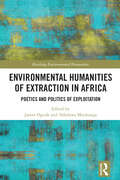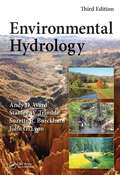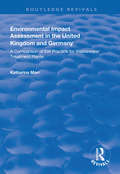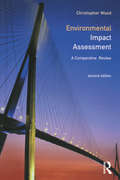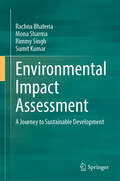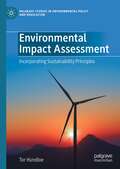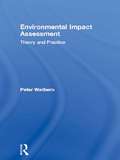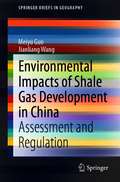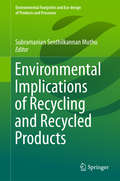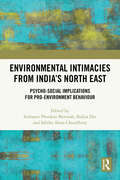- Table View
- List View
Environmental History in the Making
by Estelita Vaz Cristina Joanaz de Melo Lígia M. Costa PintoThis book is the product of the 2nd World Conference on Environmental History, held in Guimar#65533;es, Portugal, in 2014. It gathers works by authors from the five continents, addressing concerns raised by past events so as to provide information to help manage the present and the future. It reveals how our cultural background and examples of past territorial intervention can help to combat political and cultural limitations through the common language of environmental benefits without disguising harmful past human interventions. Considering that political ideologies such as socialism and capitalism, as well as religion, fail to offer global paradigms for common ground, an environmentally positive discourse instead of an ecological determinism might serve as an umbrella common language to overcome blocking factors, real or invented, and avoid repeating ecological loss. Therefore, agency, environmental speech and historical research are urgently needed in order to sustain environmental paradigms and overcome political, cultural an economic interests in the public arena. This book intertwines reflections on our bonds with landscapes, processes of natural and scientific transfer across the globe, the changing of ecosystems, the way in which scientific knowledge has historically both accelerated destruction and allowed a better distribution of vital resources or as it, in today's world, can offer alternatives that avoid harming those same vital natural resources: water, soil and air. In addition, it shows the relevance of cultural factors both in the taming of nature in favor of human comfort and in the role of the environment matters in the forging of cultural identities, which cannot be detached from technical intervention in the world. In short, the book firstly studies the past, approaching it as a data set of how the environment has shaped culture, secondly seeks to understand the present, and thirdly assesses future perspectives: what to keep, what to change, and what to dream anew, considering that conventional solutions have not sufficed to protect life on our planet.
Environmental History of Modern Migrations (Routledge Environmental Humanities)
by Marco Armiero Richard TuckerIn the age of climate change, the possibility that dramatic environmental transformations might cause the dislocation of millions of people has become not only a matter for scientific speculation or science-fiction narratives, but the object of strategic planning and military analysis. Environmental History of Modern Migrations offers a worldwide perspective on the history of migrations throughout the nineteenth and twentieth centuries and provides an opportunity to reflect on the global ecological transformations and developments which have occurred throughout the last few centuries. With a primary focus on the environment/migration nexus, this book advocates that global environmental changes are not distinct from global social transformations. Instead, it offers a progressive method of combining environmental and social history, which manages to both encompass and transcend current approaches to environmental justice issues. This edited collection will be of great interest to students and practitioners of environmental history and migration studies, as well as those with an interest in history and sociology.
Environmental History of Oceanic Islands: Natural and Human Impacts on the Vegetation of the Juan Fernández (Robinson Crusoe) Archipelago
by Tod F. StuessyThe Juan Fernández Archipelago is located in the Pacific Ocean west of Chile at 33° S latitude. Robinson Crusoe Island is 667 km from the continent and approximately four million years old; Alejandro Selkirk Island is an additional 181 km west and only one million years old. The natural impacts of subsidence and erosion have shaped the landscapes of these islands, resulting in progressive changes to their subtropical vegetation. The older island has undergone more substantial changes, due to both natural causes and human impacts. After the discovery of Robinson Crusoe Island in 1574, people began cutting down forests for lumber to construct boats and homes, for firewood, and to make room for pastures. Domesticated plants and animals were introduced, some of which have since become feral or invasive, causing damage to the local vegetation. The wealth of historical records on these activities provides a detailed chronicle of how human beings use their environment for survival in a new ecosystem. This book offers an excellent case study on the impacts that people can have on the resources of an oceanic island.
Environmental Human Rights and Climate Change: Current Status And Future Prospects
by Bridget LewisThis book examines the current status of environmental human rights at the international, regional, and national levels and provides a critical analysis of possible future developments in this area, particularly in the context of a changing climate. It examines various conceptualisations of environmental human rights, including procedural rights relating to the environment, constitutional environmental rights, the environmental dimensions of existing human rights such as the rights to water, health, food, housing and life, and the notion of a stand-alone human right to a healthy environment.The book addresses the topic from a variety of perspectives, drawing on underlying theories of human rights as well as a range of legal, political, and pragmatic considerations. It examines the scope of current human rights, particularly those enshrined in international and regional human rights law, to explore their application and enforceability in relation to environmental problems, identifying potential barriers to more effective implementation. It also analyses the rationale for constitutional recognition of environmental rights and considers the impact that this area of law has had, both in terms of achieving stronger environmental protection and environmental justice, as well as in influencing the development of human rights law more generally. The book identifies climate change as the key environmental challenge facing the global community, as well as a major cause of negative human rights impacts. It examines the contribution that environmental human rights might make to rights-based approaches to climate change.
Environmental Human Rights: A Political Theory Perspective (Routledge Explorations in Environmental Studies)
by Markku Oksanen Ashley Dodsworth Selina O'DohertyThe nature of environmental human rights and their relation to larger rights theories has been a frequent topic of discussion in law, environmental ethics and political theory. However, the subject of environmental human rights has not been fully established among other human rights concerns within political philosophy and theory. In examining environmental rights from a political theory perspective, this book explores an aspect of environmental human rights that has received less attention within the literature. In linking the constraints of political reality with a focus on the theoretical underpinnings of how we think about politics, this book explores how environmental human rights must respond to the key questions of politics, such as the state and sovereignty, equality, recognition and representation, and examines how the competing understandings about these rights are also related to political ideologies. Drawing together contributions from a range of key thinkers in the field, this is a valuable resource for students and scholars of human rights, environmental ethics, and international environmental law and politics more generally.
Environmental Humanities and Theologies: Ecoculture, Literature and the Bible (Routledge Environmental Humanities)
by Rod GiblettMany ways of thinking about and living with ‘the environment’ have their roots in the Bible and the Christian cultural tradition. Environmental Humanities and Theologies shows that some of these ways are problematic. It also provides alternative ways that value both materiality and spirituality. Beginning with an environmentally friendly reading of the biblical story of creation, Environmental Humanities and Theologies goes on to discuss in succeeding chapters the environmental theology of wetlands, dragons and watery monsters (including crocodiles and alligators) in the Bible and literature. It then gives a critical reading of the environmental theology of the biblical book of Psalms. Theological concepts are found in the works of English writers of detective and devotional stories and novels, American nature writers and European Jewish writers (as succeeding chapters show). Environmental Humanities and Theologies concludes with an appreciation for Australian Aboriginal spirituality in the swamp serpent. It argues for the sacrality of marsh monsters and swamp serpents as figures of reverence and respect for living bio- and psycho-symbiotic livelihoods in bioregions of the living earth in the Symbiocene. This is the hoped-for age superseding the Anthropocene. Environmental Humanities and Theologies is aimed at those who have little or no knowledge of how theology underlies much thinking and writing about ‘the environment’ and who are looking for ways of thinking about, being and living with the earth that respect and value both spirituality and materiality. It is a new text nurturing sacrality for the Symbiocene.
Environmental Humanities and the Uncanny: Ecoculture, literature and religion (Routledge Explorations in Environmental Studies)
by Rod GiblettSigmund Freud’s essay on the uncanny is celebrating a century. It is arguably his greatest and most fruitful contribution to the study of culture and the environment. Environmental Humanities and the Uncanny brings into the open neglected aspects of the uncanny in Freud’s famous essay in its centenary year and in the work of those before and after him, such as Friedrich Schelling, Walter Benjamin, E. T. A. Hoffmann and Bram Stoker. This book does so by focussing on religion, especially at a time and for a world in which some sectors of the monotheisms are in aggressive, and sometimes violent, contention against those of other monotheisms, and even against other sectors within their own monotheism. The chapter on Schelling’s uncanny argues that monotheisms come out of polytheism and makes the plea for polytheism central to the whole book. It enables rethinking the relationships between mythology and monotheistic and polytheistic religions in a culturally and politically liberatory and progressive way. Succeeding chapters consider the uncanny cyborg, the uncanny and the fictional, and the uncanny and the Commonwealth, concluding with a chapter on Taoism as a polytheistic religion. Building on the author’s previous work in Environmental Humanities and Theologies in bringing together theories of religion and the environment, this book will be of great interest to students and scholars of the environmental humanities, ecocultural studies and religion.
Environmental Humanities in Central Asia: Relations Between Extraction and Interdependence (Routledge Environmental Humanities)
by Jeanne Féaux de la CroixThis book is the first collection to showcase the flourishing field of environmental humanities in Central Asia. A region larger than Europe, Central Asia possesses an astounding range of environments, from deserts to glaciated peaks. The volume brings into conversation scholarship from history to social anthropology, demonstrating the contribution that interdisciplinary and engaged research offers to many urgent issues in the region: from the history of conservationism to the tactics of environmental movements, from literary engagements with ‘pure nature’ to the impact of fossil fuel extraction. The collection focuses on the Central Asian republics of the former USSR, where a complex layering of nomadic and sedentary, Turkic and Persianate, Islamic and Soviet cultures ends up affecting human relations with distinct environments. Featuring state-of-the-art contributions, the book enquires into human-environment relations through a broad-brush typology of interactive modes: to extract, protect, enspirit and fear. Broadening the scope of analysis beyond a consideration of power, the authors bring into focus alternative local cosmologies and the unintended consequences of environmental policy. The volume highlights scholarship from within Central Asia as well as expertise elsewhere, offering readers diverse modes of knowledge-production in the environmental humanities. This book is an important resource for researchers and students of the environmental humanities, sustainability, history, politics, anthropology and geography of Asia, as well as Soviet and Post-Soviet studies.
Environmental Humanities in the New Himalayas: Symbiotic Indigeneity, Commoning, Sustainability (Routledge Environmental Humanities)
by Erik De Maaker Dan Smyer YüEnvironmental Humanities in the New Himalayas: Symbiotic Indigeneity, Commoning, Sustainability showcases how the eco-geological creativity of the earth is integrally woven into the landforms, cultures, and cosmovisions of modern Himalayan communities. Unique in scope, this book features case studies from Bhutan, Assam, Sikkim, Tibet, Nepal, Pakistan, and Sino-Indian borderlands, many of which are documented by authors from indigenous Himalayan communities. It explores three environmental characteristics of modern Himalayas: the anthropogenic, the indigenous, and the animist. Focusing on the sentient relations of human-, animal-, and spirit-worlds with the earth in different parts of the Himalayas, the authors present the complex meanings of indigeneity, commoning and sustainability in the Anthropocene. In doing so, they show the vital role that indigenous stories and perspectives play in building new regional and planetary environmental ethics for a sustainable future. Drawing on a wide range of expert contributions from the natural sciences, social sciences, and humanist disciplines, this book will be of great interest to students and scholars of environmental humanities, religion and ecology, indigenous knowledge and sustainable development more broadly.
Environmental Humanities of Extraction in Africa: Poetics and Politics of Exploitation (Routledge Environmental Humanities)
by James Ogude Tafadzwa MushongaThis book brings together perspectives on resource exploitation to expose the continued environmental and socio-political concerns in post-colonial Africa. The continent is host to a myriad of environmental issues, largely resulting from its rich diversity of natural resources that have been historically subjected to exploitation. Colonial patterns of resource use and capital accumulation continue unabated, making environmental and related socio-political problems a dominant feature of African economies. The book pursues the manifestation of these problems through four themes: environmental justice, violent capitalocenes, indigenous knowledge, and climate change. The editors locate the book within the broad fields of political ecology and environmental geopolitics to highlight the intricate geographies of resource exploitation across Africa. It uniquely focuses on the socio-political and geopolitical dynamics associated with the exploitation of Africa’s natural resources and its people. The case studies from different parts of Africa tell a compelling story of resource exploitation, related issues of environmental degradation in a continent particularly vulnerable to climate change, and the continued plundering of its natural resources. The book will be of great interest to scholars and students from the interdisciplinary fields of the environmental humanities and environmental studies more broadly, as well as those studying political ecology, environmental policy, and natural resources with a specific focus on Africa.
Environmental Hydrology (Third Edition)
by Andy D. Ward Stanley W. Trimble Suzette R. Burckhard John G. Lyon<p>The first and second editions were bestsellers and the third promises to educate people new to the field of hydrology and challenge professionals alike, with insightful solutions to classical problems as well as trendsetting approaches important to the evolving genre. The third edition enhances materials in the second edition and has expanded information on many topics, in particular, evapotranspiration, soil erosion, two-stage ditch design and applications, and stream processes. <p>What’s New in the Third Edition: <p> <li>Presents new sections on rock structures in streams, hypoxia, harmful algal blooms, and agricultural practices to reduce nutrient discharges into water resources <li>Enhances the format to aid the reader in finding tables, figures, and equations <li>Contains more than 370 figures, 120 tables, 260 equations, 100 worked examples, 160 problems, and more than 1000 references</li> <p> <p>Collectively, the authors have more than 130 years of international experience and the addition of John Lyon and Suzette Burckhard as co-authors expands the breadth of knowledge presented in this book. More than 60 scientists and engineers in Australia, Canada, Europe, and the United States provided assistance to round out the offerings and ensure applicability to hydrology worldwide.</p>
Environmental Impact Assessment in the United Kingdom and Germany: Comparision of EIA Practice for Wastewater Treatment Plants (Routledge Revivals)
by Katharina MarrFirst published in 1997, this volume examines wastewater treatment plants in the UK and their counterparts in Germany in the wake of the International Study of the Effectiveness of Environmental Assessment (1996). Having originated in the United States National Environment Policy Act of 1969, the basic concept of EIAs has been adopted around the world and are highly diverse today. This study aims to examine, compare and suggest improvements for EIA practices as applied to wastewater treatment in the UK and Germany.
Environmental Impact Assessment: A Comparative Review
by Chris WoodEnvironmental Impact Assessment (EIA) has become a vital management tool worldwide. EIA is a means of evaluating the likely consequences of a proposed major action which will significantly affect the environment, before that action is taken.This new edition of Wood's key text provides an authoritative, international review of environmental impact assessment, comparing systems used in the UK, USA, the Netherlands, Canada, the Commonwealth of Australia and New Zealand and South Africa.
Environmental Impact Assessment: A Journey to Sustainable Development
by Mona Sharma Sumit Kumar Rachna Bhateria Rimmy SinghThis book will cover the basic principles and salient features of EIA. The authors attempt to cover the shortcomings observed in EIA reports, the manner of conducting EIA for proposed projects, and also to facilitate the preparation of good quality EIA reports. The book is written in a straightforward format avoiding long descriptive texts to enhance the reader experience Although the focus is on the Indian context, the concepts and techniques of EIA described in this book are applicable universally. An Environmental Management Plan (EMP) is also discussed, and this is an essential aspect of EIA in countries where priority is on economic development by way of development projects and when the EIA process has inherent weaknesses. For the continual improvement of EIA reports, EIA consultants maybe assigned the task of implementing and operationalizing the suggested EMP in addition to conducting an EIA study and in preparation of an EIA report. The system of peer review of EIA reports is also expected to improve EIA quality. “Environmental Impact Assessment: A Journey to Sustainable Development” is an attempt to cover EIA according to new knowledge acquired through research and experiences which will make this tool more versatile and dynamic. The authors recognise that since EIA is continuously expanding and developing there will always be potential for improving the scope of this book to make it more useful to the users as per their requirement. This book will be of interest to academics, EIA professionals and consultants, EIA review/appraisal authorities and particularly stakeholders in emerging economies where major developmental work is being undertaken and which is expected to continue in decades to come.
Environmental Impact Assessment: Incorporating Sustainability Principles (Palgrave Studies in Environmental Policy and Regulation)
by Tor HundloeThis book provides a detailed treatment of the ecological, economic and social impacts in the context of environmental impact assessment (EIA) and makes clear the necessary link between EIA and the sustainability principles of protecting biodiversity, risk aversion, and inter and intra-generational equity. It proposes that the benefits and costs of a project need to be weighted according to who bears them, giving particular attention to the planet’s poor. Furthermore, this book presents a comprehensive analysis of environmental offsetting which has come to be commonly resorted to when negative impacts cannot be mitigated. In this context, the book argues that offsetting is only viable if advanced offsets are quarantined through a Strategic Environmental Impact approach. Finally, the book explores the role of the various disciplines which need to be mastered in undertaking an EIA.This book takes you on a journey from the beginning of environmental impact assessment to the present day. It is a scholarly warts and all study. For each trial and tribulation, Hundloe presents a remedy. It is essential reading and an invaluable reference for environmental practitioners, politicians, policy makers, academics and, the most important group, future environmental practitioners.
Environmental Impact Assessment: Theory and Practice
by Peter WathernThis comprehensive treatment of environmental impact assessment (EIA) provides an authoritative contemporary review of theory and practice over the past ten years. EIA is viewed as both science and art, reflecting the concern both with technical aspects of appraisal and the effects of EIA on the decision-making process. Adopted in many countries, with different degrees of enthusiasm, since its inception in the early 1970's, EIA is established as a major procedure for assessing the environmental implications of legislation, the implementation of policy and plans and the initiation of development projects. EIA is increasingly an essential part of environmental management
Environmental Impact of Ships (Cambridge Environmental Chemistry Series)
by Stephen De Mora Timothy Fileman Thomas VanceShipping is responsible for transporting 90% of the world's trade. This book provides a comprehensive review of the impact shipping has on the environment. Topics covered include pollutant discharges such as atmospheric emissions, oil, chemical waste, sewage and biocides; as well as non-pollutant impacts including invasive species, wildlife collisions, noise, physical damage, and the environmental effects associated with shipwrecks and shipbreaking. The history of relevant international legislation is also covered. With chapters written by eminent international authors, this book provides a global perspective on the environmental impact of ships, making it a useful reference for advanced students and researchers of environmental science, as well as practitioners of maritime law and policy, and marine business.
Environmental Impacts of Pasture-based Farming
by Richard W. McdowellFocusing on the different types of pastoral farming and their impact on the environment, Environmental Impacts of Pasture-based Farming takes a broad view of the subject, whose treatment in texts is often biased towards confined animal or grain based systems. The text is organized into two sections, the first addressing issues facing environmental quality, namely soil, water and air quality and socio-economic impacts. The second section offers commentary on how pastoral sectors influence environmental issues. With highly tuned farm productive systems comes the risk of environmental impacts, and the purpose of this text is to highlight the areas in which these risks are associated and how best to mitigate them. An approach is taken that highlights these problems, but also keeps in mind that mitigation may be too restrictive on the farming system and make farming impractical.
Environmental Impacts of Shale Gas Development in China: Assessment and Regulation (SpringerBriefs in Geography)
by Jianliang Wang Meiyu GuoThis book features a comprehensive analysis of the development of shale gas resources in China, with a focus on the potential environmental impacts that may result. China has the world’s largest shale gas resources, which it is keen to develop to alleviate air pollution and successfully transition to a low-carbon energy future. However, one significant obstacle standing between the ambition and reality is the potentially serious environmental impacts of shale gas production. This book offers a systematic assessment of these potential impacts, including the risk of water contamination, ecological disruption due to the huge consumption of water and methane leakage. It presents valuable first-hand data collected from the authors’ fieldwork in Sichuan and Chongqing and the latest information on China’s current shale gas operations and also includes a set of models and methods developed to quantify the impacts. It allows readers to gain a deeper understanding of environmental regulatory management systems regarding shale gas production in China by examining whether the existing monitoring, reporting and verification (MRV) systems and environmental regulations can effectively prevent adverse impacts from shale gas production. Providing a detailed study of shale gas development in China based on an unprecedented primary dataset, the book is a valuable resource for scholars, engineers and students who are interested in the energy development and environmental risks.
Environmental Implications of Recycling and Recycled Products
by Subramanian Senthilkannan MuthuThis book includes details on the environmental implications of recycling, modeling of recycling, processing of recycled materials, recycling potential of materials, characterisation of recycled materials, reverse logistics, case studies of recycling various materials etc.
Environmental Indicators in Metal Mining
by Bernd LottermoserThis book represents an important new contribution to the literature that presents practical and comprehensive solutions to mining activities. Its timely content has been prepared by several experts from around the world and its practical format addresses the major environmental predictive techniques required for the extraction and processing of metal resources. Packed with reviews and case studies, it covers current methods used to forecast environmental effects of metal mining.
Environmental Information for Naval Warfare
by Committee on Environmental Information for Naval UseAccurate and timely environmental information can provide a tactical advantage to U. S. naval forces during warfare. This report analyzes the current environmental information system used by the U. S. Navy and Marine Corps and recommends ways to address uncertainty and leverage network-centric operating principles to enhance the value of environmental information.
Environmental Information: Research, Access & Environmental Decisionmaking
by Sarah Lamdan<P>In an ideal world, environmental information would be easy to find and use. But the current state of environmental information access requires additional knowledge and expertise--the kind that this book provides. <P>Designed for legal practitioners, librarians, journalists, advocates, students, and researchers, this book helps environmental information seekers locate, obtain, and make sense of environmental records, documents, and pieces of data. <P>It contains tips and concepts that expand beyond legal research or general research and into the broader realm of information-gathering. <P>The book discusses environmental research tactics and resources and it also covers methods for obtaining information from nontraditional sources like government offices and open meetings.
Environmental Infrastructure in African History
by Emmanuel KreikeEnvironmental Infrastructure in African History offers a new approach for analyzing and narrating environmental change. Environmental change conventionally is understood as occurring in a linear fashion, moving from a state of more nature to a state of less nature and more culture. In this model, non-Western and premodern societies live off natural resources, whereas more modern societies rely on artifact, or nature that is transformed and domesticated through science and technology into culture. In contrast, Emmanuel Kreike argues that both non-Western and premodern societies inhabit a dynamic middle ground between nature and culture. He asserts that humans- in collaboration with plants, animals, and other animate and inanimate forces - create environmental infrastructure that constantly is remade and reimagined in the face of ongoing processes of change.
Environmental Intimacies from India’s North East: Psycho-Social Implications for Pro-Environment Behaviour
by Indranee Phookan Borooah Sabiha Alam Choudhury Bidita DasThis book explores the intimate relationship of the people of North East India with the environment as evinced from their traditional beliefs, cultural practices, and livelihood. It offers insights into the challenges and adaptability of communities through actions ensuring conservation of the environment yet sustaining their livelihood.The book encompasses movement toward responsible actions and the engagement of communities in pro-environmental behavior. It showcases the various practices, knowledge, and debates on the environment-behavior relationship of the people of North East India. It brings into focus some of the daunting environmental issues and the endeavors for sustenance that is true to a region which is rich in ecological diversity and touches the spirit and psyche of its people.This volume will be of interest to scholars and researchers of psychology, anthropology, sociology, environmental sciences, development studies, law and governance, environmental administration, and South Asia studies.


